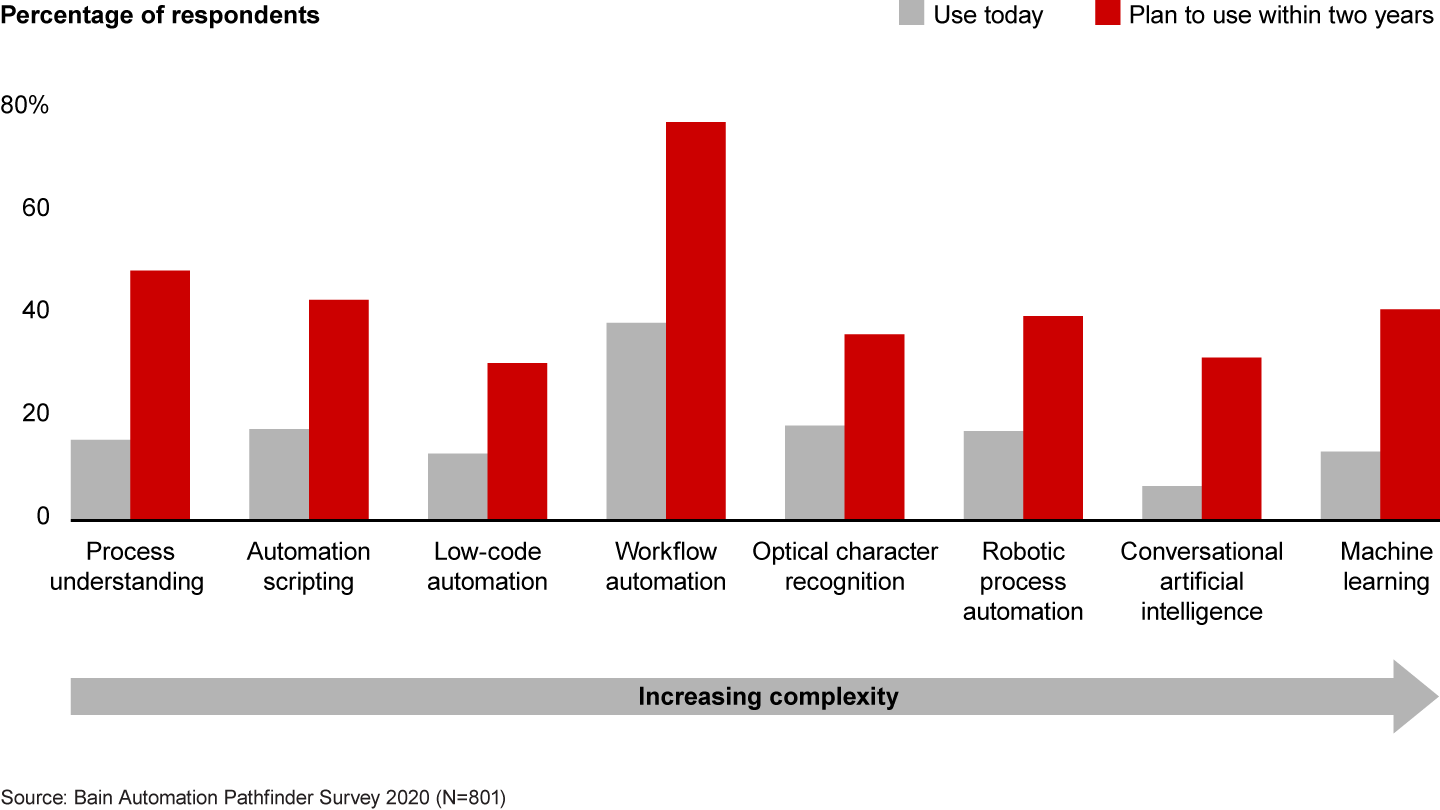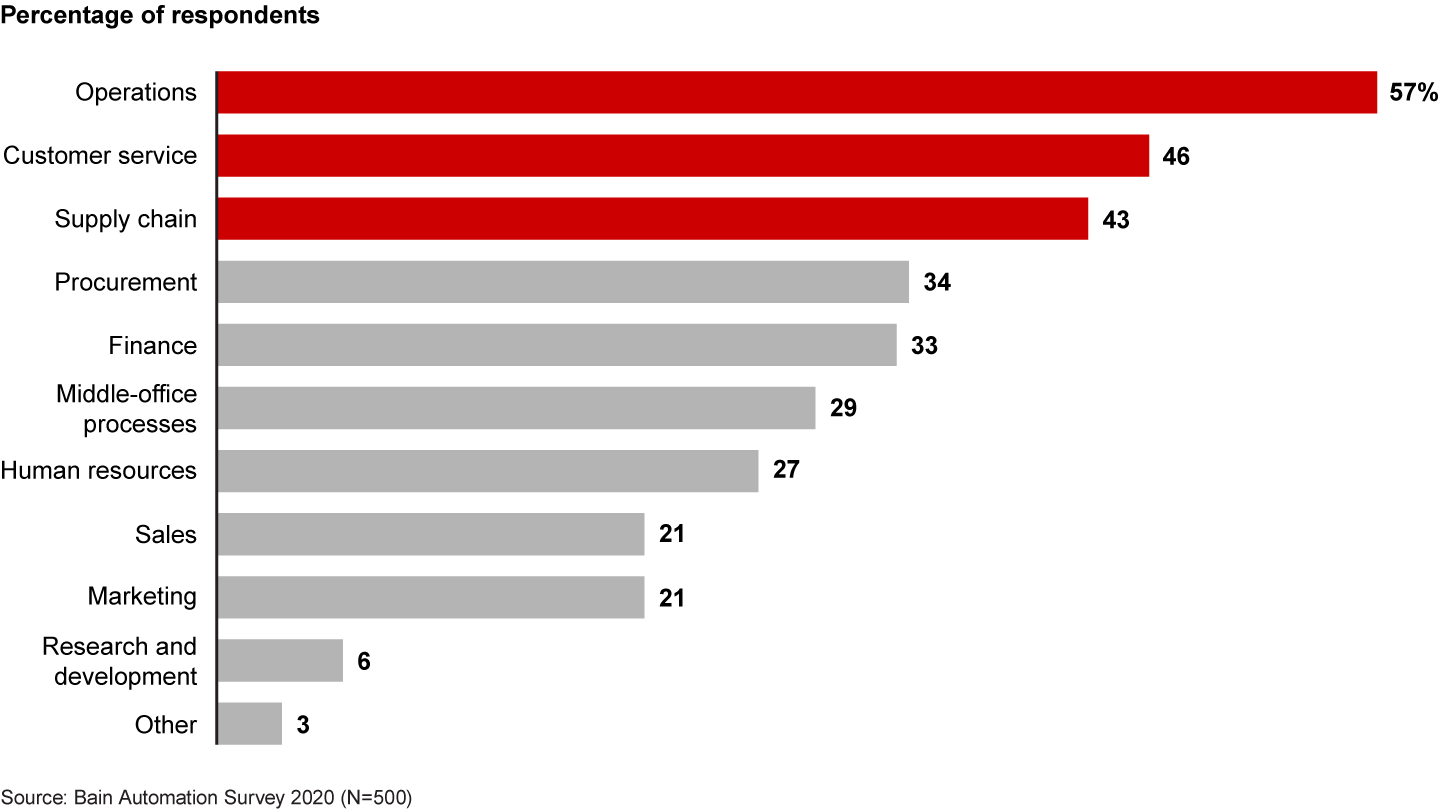Brief

The most transformative technological trend of the past decade has been cloud technology, and automation played an important role.
By all measures, cloud computing is a massive success, accounting for 80% of all IT growth from 2015 to 2019, with revenue exceeding $200 billion. Four large providers—namely, Amazon Web Services (AWS), Microsoft Azure, Google Cloud Platform, and Alibaba—hold more than 60% of the infrastructure-as-a-service and platform-as-a-service markets.
Hyperscale computing—that is, the ability of a technology architecture to scale quickly, seamlessly, and appropriately as demand increases—made it possible for these providers to deliver IT infrastructure services more effectively and less expensively than traditional computing. A core element of hyperscale computing is automating the handling of hundreds of millions, if not billions, of users, actions, and transactions. Without automation, providers would struggle to make the business model work.
Cloud computing illustrates how automation can do more than save money by automating discrete tasks in a process; it demonstrates how automation can create entirely new customer value propositions, disrupt industries, and enable new business models.
The pandemic is requiring many leaders to think more boldly about what automation can do for their businesses (see Figure 1). Lowering costs will remain a top reason to automate, but, in response to the pandemic, companies increasingly are deploying automation to strengthen business resilience, reduce risk, and generate useful business insights more easily.

As companies try to get more out of automation, they are looking at an array of technologies (Figure 2). Automation software providers are responding by expanding their capabilities and developing platforms that combine multiple technologies, such as artificial intelligence (AI), robotic process automation (RPA), workflow automation, and optical character recognition.

RPA software providers are one example. UiPath, Automation Anywhere, and Blue Prism are each combining RPA with process mining, process discovery, and low-code development tools, resulting in broader hyperautomation platforms that more than double the size of their addressable market from $25 billion to about $65 billion. They are establishing partnerships to integrate their offerings with leading enterprise software providers, including SAP, Oracle, Workday, and Salesforce. By doing this, the goal of these RPA providers is to automate processes more effectively and to help create greater value beyond cost savings.
Three examples of expanding the aperture of automation beyond cost savings are creating capacity for growth, transforming and building resilience into operations, and enhancing the customer experience.
Creating room for growth
For fast-growing businesses, the processes of recruiting, onboarding, and developing talent can often impede growth. Many of these companies also find it challenging to scale business processes to match growth. Some throw more people at the problem, but that can lead to a complex web of nonstandard policies, processes, and systems that need to be cleaned up later, diverting spending that could have been better invested in growth.
Automation can help alleviate the talent challenges, make business processes more scalable, and free up spending to invest in growth.
Those were the goals for a fast-growing healthcare provider in Asia-Pacific that wanted to double its cash flow over the next three years, rapidly expand its domestic network, acquire and integrate global businesses, and build an industry-leading AI platform.
To achieve this, the provider accelerated its automation program to free up capacity within its support functions. It also automated work in the traditional support functions, such as finance and procurement. More importantly, the provider sought automation opportunities across the patient care process from activities in the referral and pre-appointment stages to the reporting of patient results from physicians. The automation helped the support teams respond to increased demand without taking on more staff, thereby enabling profitable growth.
The company expects the new automation program to increase capacity within these functions and processes by 30%, saving millions of dollars that could be reinvested in growth and improved margins.
Transforming operations to be more resilient
Supply chain disruptions have become more frequent and significant, owing to geopolitical events (such as Brexit), extreme weather events, cybersecurity attacks, and health crises. During the Covid-19 pandemic, many executives said they wished they had used more automation in their operations and supply chains before the outbreak (Figure 3).

In addition, many industries are transforming—for example, brick and mortar shifting to e-commerce in retail or traditional on-premise software shifting to software as a service. All of these factors are causing companies to reinvent their operations and supply chains to improve resilience.
For media company Discovery, the impetus to automate was the ever-increasing complexity of managing all the video content for its 600 production partners. The company exhausted thousands of hours accepting and processing video from a wide variety of partners that use different types of content and formats. Its supplier base was vast, with different levels of technical maturity, which meant that many content deliveries arrived with errors. All this led to a rocky experience for many producers, significant manual work, human error, and long cycle times to process the content.
To transform, Discovery built an automated media supply chain in the cloud to expedite the content submission process. A supplier portal standardized the intake process. The platform then automated data ingestion, data validation and the processing of media files. Through this new platform, Discovery redefined content submission. It also improved the experience of producers, since manual data entry was no longer needed on most metadata fields and the entire submission process was reduced to about two and a half hours. The company eliminated human effort in many cases, streamlined intake operations from its suppliers, and provided a near-real-time view of its supply chain, which permitted Discovery to prioritize new channels of content as opportunities emerged.
Enhancing the customer experience
Automated self-service has been driving down costs for decades. What’s changing now is that companies are embracing automation to enhance the customer experience and improve loyalty as well. Automation can help companies improve engagement with their customers, personalize the customer’s experience, empower and assist customers with common tasks, and resolve customer issues faster.
Brazilian clothier Marisa used automation in combination with other tools to improve customer service when its call center volume escalated during the Covid-19 pandemic. With more online orders came more customer calls about delivery and other issues. Marisa’s executives deployed automation to reduce the number of customer interactions with agents, improve its retention of customers who interact with voice recognition and chat bots, and make agents more productive.
Early results are promising. By improving decision trees, Marisa was able to identify customer needs more precisely and, in many cases, resolve issues without involving an agent. Customer retention in the voice recognition system improved from 14% to 35%. Self-service capabilities also improved, including options for customers to receive text notifications on order status. As a result, customers were happier, and customer satisfaction scores rose.
Unlocking the value of automation beyond cost savings
Many executives are so accustomed to thinking of automation primarily as a cost-saving tool that it can be difficult to broaden their outlook to the other opportunities it affords. Three principles can help them begin to see automation in a new light, one that continuously pushes on the potential and creates a mindset that looks for more from these technologies.
First, assess whether automation will be a threat, opportunity, or both to the business. Executives should explore the role that automation could play in reinventing customer experiences and business models within their industries, just as it has in cloud computing. From there, they can work backward to understand the impact that automation will have on specific customer interactions and business processes, and build the roadmap and business case to get there.
Second, reinvent business processes with automation inside rather than finding lots of individual tasks to automate. While automating a single task can yield savings, doing so is often too fragmented to have a real impact. A programmatic approach transforms processes and the business.
Third, treat automation as a major change to manage actively from the start. The barriers to automation are falling, but that doesn’t mean companies can cut corners in planning and executing their automation strategy. Successful automation requires more than great technology; it begins with strong C-level sponsorship so that it remains a priority and everyone is held accountable for achieving the company’s ambitious targets.
For companies that continue to view automation primarily as a way to reduce costs around many small tasks, achieving its full potential will prove challenging. Those companies that can learn to reimagine their businesses through automated capabilities, however, stand to build a competitive edge within their industries.


